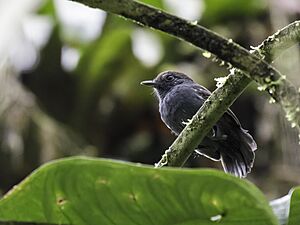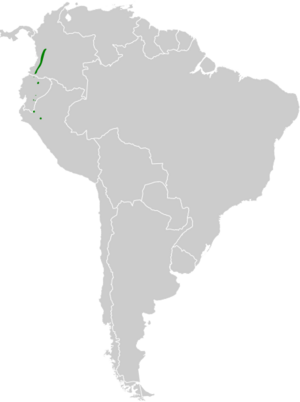Bicolored antvireo facts for kids
Quick facts for kids Bicolored antvireo |
|
|---|---|
 |
|
| Conservation status | |
| Scientific classification | |
| Genus: |
Dysithamnus
|
| Species: |
occidentalis
|
 |
|
The bicolored antvireo (Dysithamnus occidentalis) is a small bird that eats insects. It is part of the "typical antbirds" family. This bird is considered Near Threatened, meaning its population is decreasing. You can find it in Colombia, Ecuador, and Peru.
Contents
About the Bicolored Antvireo's Name
The bicolored antvireo was first described by an American bird expert named Frank Chapman in 1923. At first, he thought it was a type of subspecies of another bird, the white-shouldered antshrike. He gave it a long scientific name: Thamnophilus aethiops occidentalis.
Later, scientists realized this bird was different. They decided it belonged to a different group, or genus, called Dysithamnus. This is why its scientific name changed to Dysithamnus occidentalis.
This bird has two main types, called subspecies: D. o. occidentalis and D. o. punctitectus. Even though punctitectus was described as its own species first, occidentalis was described earlier (even in a different group). Because of a rule called the principle of priority, the first name given, occidentalis, became the main one.
What Does the Bicolored Antvireo Look Like?
The bicolored antvireo is about 13 to 13.5 centimeters (5 to 5.3 inches) long.
- Males of the main subspecies (D. o. occidentalis) have a dark gray head, back, and tail. They have a hidden white patch on their shoulders. Their wings are black with white dots on some feathers. Their belly is a slightly lighter dark gray.
- Females of this subspecies have a reddish-brown cap and back. Their wing feathers have buffy white spots. Their face, throat, and chest are dark gray with thin white stripes. Their belly and the feathers under their tail are olive-brown.
Both male and female birds of the D. o. punctitectus subspecies are paler, meaning they are lighter in color than the other type. Their smaller wing feathers are completely white.
Where Do Bicolored Antvireos Live?
The bicolored antvireo lives in separate areas, which scientists call a disjunct distribution.
- The D. o. occidentalis subspecies lives in the northern parts of its range. You can find it on the western side of the Andes mountains in southern Antioquia Department in Colombia, going south into northern Carchi Province in Ecuador.
- The D. o. punctitectus subspecies lives on the eastern side of the Andes. It is found in Ecuador's Napo and Morona-Santiago provinces. It also lives in Peru's Amazonas and San Martín departments.
These birds like to live in the lower parts of wet mountain forests that stay green all year. They often prefer natural open spots, like where a tree has fallen. They live at different heights depending on the country:
- In Colombia, they are found between 1,600 and 2,400 meters (5,200 and 7,900 feet) high.
- In Peru, they live between 2,000 and 2,500 meters (6,600 and 8,200 feet) high.
- In northern Ecuador, they are found around 2,200 meters (7,200 feet) high.
- On the eastern side of the Andes, they live between 1,500 and 2,050 meters (4,900 and 6,700 feet) high.
Bicolored Antvireo Behavior
Movement
Scientists believe the bicolored antvireo stays in the same area all year long. It does not migrate.
Feeding Habits
The bicolored antvireo mostly eats insects and other arthropods, which are creatures like spiders. It usually looks for food alone or with one other bird. It never joins groups of different bird species that feed together. This bird typically feeds within 2 meters (6.6 feet) of the ground. It often reaches from a branch to pick food off leaves and twigs. It also flies out from a perch to catch insects.
Life Cycle and Reproduction
Only one nest of a bicolored antvireo has ever been found. It was in Ecuador in December. The nest was shaped like an open cup. It was made of plant fibers and small branches. It was built in a fork of a branch and hidden by leaves. The nest held one baby bird, and both parents were feeding it. Not much else is known about how these birds raise their young.
Vocalization
Scientists are not completely sure what the bicolored antvireo's main song sounds like. One of its calls might actually be its song.
- In Ecuador, its most common call is a "fast throaty scold" that sounds like "jeér-deer-dur." It also makes clear "peeu" calls and a fast, rising sound like "pu-pu-pooyeh?"
- In Peru, some experts describe a sound as a song: "an accelerating, descending series of clear rising whistles: WEE wee-wee-wee-whe'he'huhu." Calls in Peru are described as a deep, chattering growl: "prr'r'r'r" and a rising series of whining notes: "dew dew dwi-dwee-dwee?".
Status of the Bicolored Antvireo
The IUCN (International Union for Conservation of Nature) is an organization that checks how endangered animals are. In 1994, the IUCN first said the bicolored antvireo was "Vulnerable." In 2022, they changed its status to "Near Threatened." This means it is still a concern, but less so than before.
The bicolored antvireo lives in only a few separate places. Its population is estimated to be between 7,300 and 8,000 adult birds, and this number is believed to be going down. The bird has lost a lot of its natural home because of farming, especially in Ecuador. Many suitable forests have been cleared there. However, some large areas of untouched forests still exist in places like the Cordillera de Guacamayos and Volcán Sumaco.
Even in some areas in Colombia that are supposed to be protected, the bird's habitat is still shrinking. This is because these areas are either surrounded by cleared land or people are building homes there. The bicolored antvireo is considered uncommon in Colombia. It is rare and not well-known in Ecuador and Peru.


